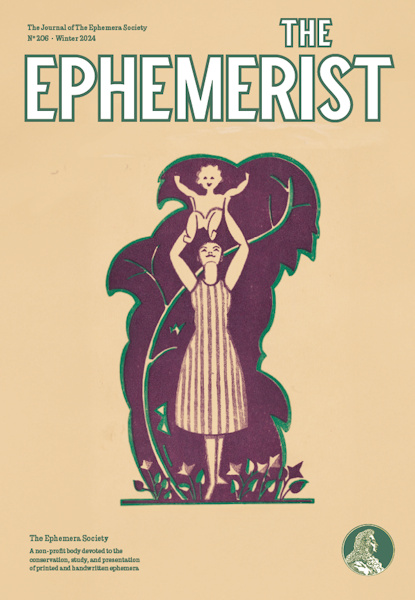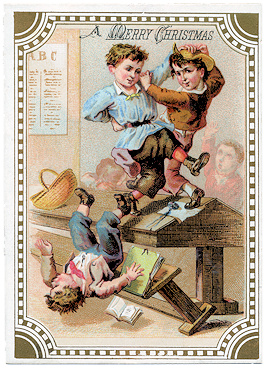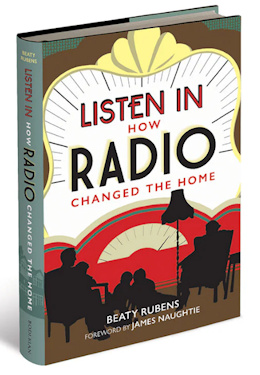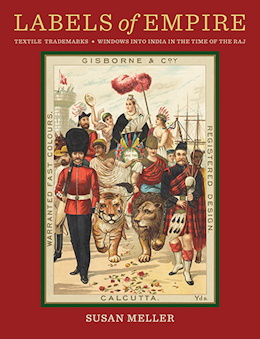The Ephemera Society News

The Ephemera Society Journal
Winter 2024 issue Nº 206
The Ephemerist, the society’s illustrated journal, was posted to members in February 2025.
We start the year with some important changes to the Society to share... please
read more about our exciting future plans in ‘Society News’ on pages
2 & 3, and share your views with our Chair, Dickon Weir-Hughes.
Readers should not miss the new exhibition displaying ephemera
about early radio at the Bodleian Library’s Special Collections, some
of which is illustrated in Ruben’s article on p4. Reid describes the
unusual career of a female ‘printer stationer’ of Islington, Sarah
Burgess, who leaves a legacy of celebration napkins, and Hickman-
Robertson has picked up the ‘Ephemeral day in —’ baton with tales of
collecting ephemera in 1970s Canton (Guangzhou). Regular columns
N&Qs and Mrs Pepys complete a varied and interesting issue.
The cover features an illustration from Home, Health and Garden 1934.
Call For Articles!
The Ephemerist
 We have three future ephemera themes in
the pipeline! If any collectors or writers
would like to contribute on the theme of
CHILDHOOD the Editor would be delighted
to hear from you!
We have three future ephemera themes in
the pipeline! If any collectors or writers
would like to contribute on the theme of
CHILDHOOD the Editor would be delighted
to hear from you! Examples might include:
Birthdays, Child-oriented
advertising
Church: Attendance, Choir,
Baptism, Funerals, Burial, Reward Cards
Needlework: Samplers, Gifts,
Reading: Alphabets,Books, Bookplates
Schools:
Reward cards, Education, Private Schools, Curricula,
Reports, Classrooms (desks, ink, slates)
Sport, Stationery, Toys, Board Games, Card Games,
Playing Cards, Costume,
Employment, Gardening, Greetings cards,
Health, Medicine ::Our
second theme is GRAPHIC DESIGN.
Examples might include: Advertising, Film,
Exhibition catalogues, Type Specimens,
Well-known designers, Art and design
styles, eg Art Deco, Art Nouveau, Punk etc.,
and practitioners using ephemera as
inspiration in their work.
::
Our third theme is TRANSPORT. Examples
might include any ephemera to
relating to aeroplanes, trains, buses, cars,
bicycle and horse drawn carriages, including
Maps, Tickets, Timetables, Travel Posters,
Airline and Train menus, Luggage labels.
Listen In How Radio Changed the Home
By Beaty Rubens

Join the journey of Listen In as we uncover the sensational early days of radio through never-before-heard testimonies from listeners. With heart-warming tales, humorous illustrations, and witty cartoons, witness how radio revolutionised family life.
Radio today evokes feelings of familiarity and comfort, background noise to ease the silence. Its early history, however, was far more exciting. Between 1922 and 1939, British life was transformed by what was known as the ‘Radio Craze’.
Listen In explores the impact of radio on a personal level through the experiences of those who were there before and during its circulation into the home. The then-radical form of technology revolutionised life within the private sphere, whereby families could tune into outside voices and music, SOS calls, the Pips, the News, sport, royalty and innovative radiogenic comedy.
Generously illustrated and drawing on contemporary journalism, fiction, diaries, cartoons and a remarkable cache of unpublished first-person testimonies discovered in the archives of the Bodleian Library in Oxford, Listen In is packed with entertaining and thought-provoking stories. It comes at a timely moment when traditional linear radio is shifting in response to podcasting, and the entire experience of how we consume audio is once again undergoing transformation.
Hardback • 272 pages, • ISBN 9781851246311
More details: Listen In
Labels of Empire
By Susan Meller

The book focuses on a little known, but highly important, aspect of late 19th and early 20th century British (and Indian) textile industries - the fantastic chromolithographed paper labels that textile manufacturers and their agents pasted on their yard goods. Called “shipper’s tickets" in the trade, they were in effect the companies’ brands and were designed to catch the eye of shoppers in the bustling Indian markets. The images shown on the labels accurately depict the pantheon of Hindu deities; maharajas; dancing girls; daily Indian life; etc. - all rendered with exquisite detail.
Labels of Empire begins with the late 19th-century heyday of British textile manufacturing and closes with Indian independence in 1947. By combining visual narrative, popular culture, magical realism, and history in a way never done before, this book offers an unprecedented look at the British and Indian textile industries in the time of the Raj through their remarkably successful use of attractive paper labels as trademarks. Serving as a premium of sorts, most of these labels survived because they were collected, saved and often framed by the Indian people - then and now. Today these long-surviving pieces of "ephemera” are being recognized for their beauty and their role in the history of the textile trade.
Hardback • 544 pages • Size: 9¼ x 12 inch • Colour images throughout
More details: Labels of Empire
|



 We have three future ephemera themes in
the pipeline! If any collectors or writers
would like to contribute on the theme of
CHILDHOOD the Editor would be delighted
to hear from you!
We have three future ephemera themes in
the pipeline! If any collectors or writers
would like to contribute on the theme of
CHILDHOOD the Editor would be delighted
to hear from you! 
